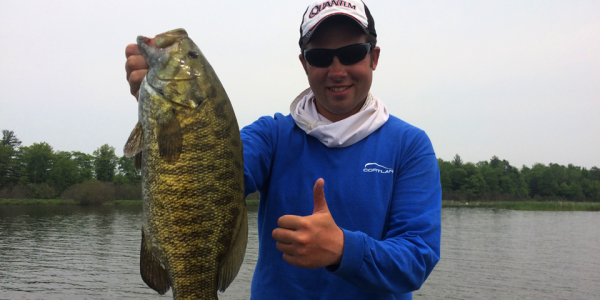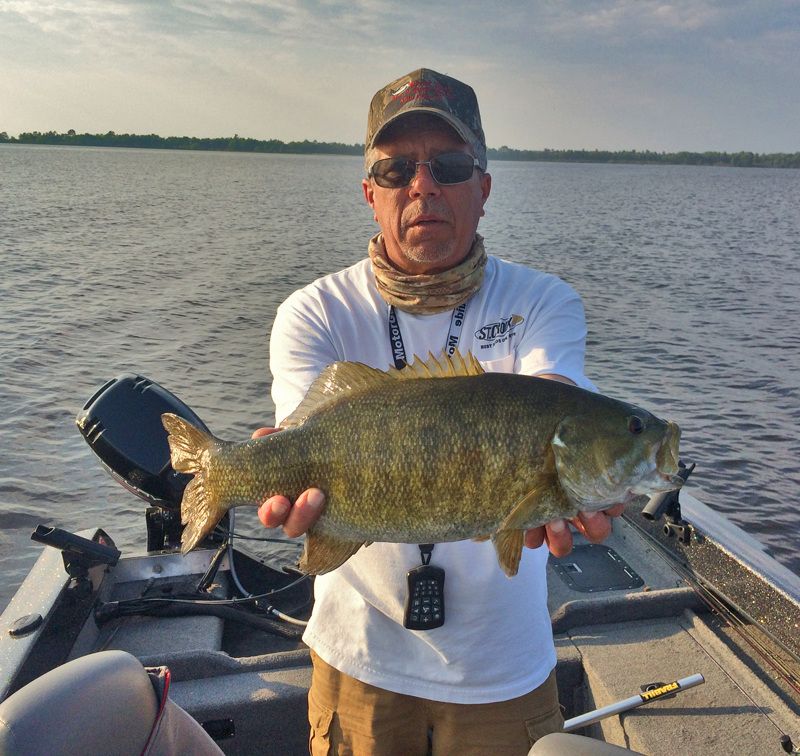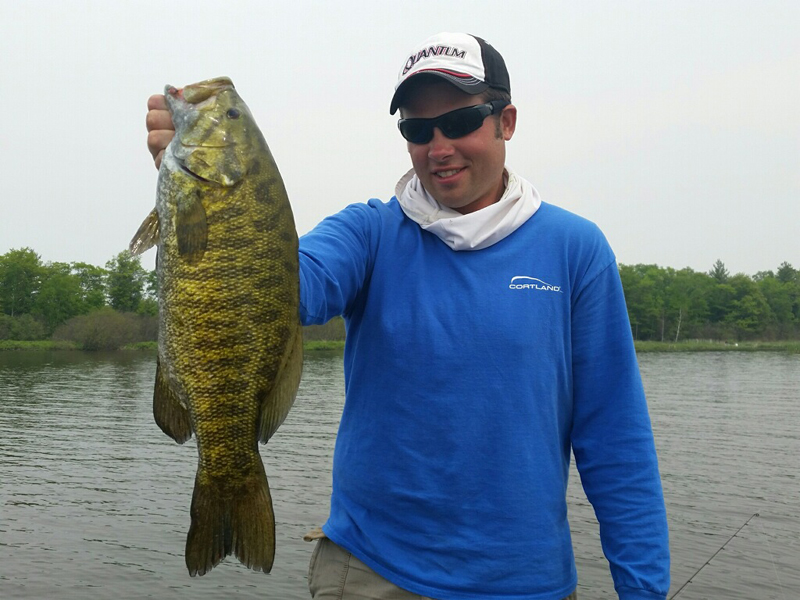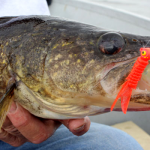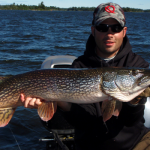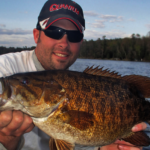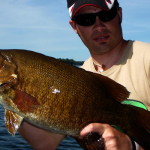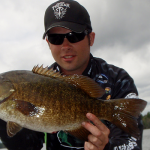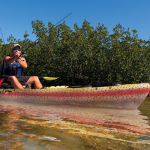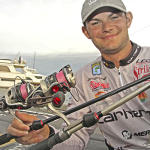Ashland Wisconsin’s Chequamegon Bay is the destination where every bass fisherman’s big fish dreams come true.
By Andrew Ragas
Smallmouth bass populations are expanding across the Great Lakes region. As a result, their fisheries are growing to world class proportions, and are now capable of challenging world record size. In the north country of Wisconsin, the heart of fishing for giant Great Lakes smallmouths centers on the southwest shore of Lake Superior, in the fertile waters of Chequamegon Bay.
A 40,000 acre basin with an average depth of 18 feet, Chequamegon Bay is separated from the cold water of Lake Superior by Long Island. This narrow strip of land extends 5 miles northwest into Lake Superior, and forms the makeup of the bay, creating a natural shield from the lake’s frigid waters. The shallow, warm water ecosystem created by Long Island is what helps generate self-sustaining gamefish populations and the successful fishing opportunities for them.
Rated as one of the best smallmouth bass fisheries in North America, Chequamegon Bay draws hundreds of bass fishermen annually. Nate Baron, of Up North Guide Service (www.upnorthguideservice.net) and River Rock Inn Bait and Tackle of Ashland, WI, has been helping bass anglers turn their big bass dreams into reality since 2011 when he received his USCG captain’s license.
Born and raised in Ashland, Baron fishes the bay 100 days per year for multi-species, and averages about 60 smallmouth trips per season. Growing up fishing the bay in the 1970’s, “22 to 25 inch smallmouth bass were once common to catch,” he says. But that lasted for only so long, until populations crashed to dangerous levels in the 1980’s due to liberal keep-all regulations and mass exploitation of the fishery. With today’s management plan in place (enacted in 1994) with virtually zero smallmouth harvest thanks to the 22 inch size limit, those ‘good ole days’ are back again.
“A state record smallmouth bass definitely exists somewhere in here now,” says Baron. “That’s what makes it so exciting to fish this water!” he concludes.
The Bay’s Smallmouth Bass Fishery
Avid smallmouth anglers seek quality fish, and the opportunities to be on world class waters. My first time visit to the bay with Baron, aboard his Tuffy Osprey 1990, validated that experience for me. Regardless of high expectations, Ashland receives many tourists each season, who want nothing more than the opportunity to catch fish of any size. A lot of Baron’s bass clients prefer to catch numbers, but on Chequamegon Bay most fish are already of trophy caliber, with an astonishing 19 inch average size. Therefore, it’s not hard to find trophies and numbers. Anglers fishing the bay will get the best of both worlds.
“Chequamegon Bay is an amazing smallmouth factory, starting from two days after ice out in spring lasting until the day it freezes over again,” says Baron. During pre spawn through post spawn, 60 to 80 fish days are not uncommon for him and many other guides who fish the bay. Otherwise, in the summer and fall months when fish move deep, 30 to 40 fish days like the day we experienced together is the norm.
Bass anglers on the bay have opportunities to catch big fish during any time of the open water season. However, Baron suggests that specific seasonal periods such as early spring and late fall are best. “The best shot at the largest smallmouth comes in late fall, when 6 and 7 pounders are more abundant,” says Baron. “Mid October until first ice is prime time,” he affirms.
Anglers fishing the bay must be willing to move around a lot and cover lots of water. “You may locate 20 fish on a drop-off or weed patch one day, only to find zero the next day,” he says. As I experienced with Baron during the calmest of days in mid June, it’s rare to catch a smallmouth under 18 inches here. It’s also not uncommon to catch over a dozen fish surpassing 20 inches in a single day.
Catch and release fishing regulations, coupled with the bay’s ideal habitat and high fertility, is what makes this smallmouth fishery thrive.
Ideal Smallmouth Habitat
The smallmouth’s usage of specific habitat “Depends on the time of season,” says Baron. Much of the bay’s excellent smallmouth habitat is focused on the sunken, discarded wood left behind from the historic logging days of the late 1800’s and early 1900’s.
In the old logging days, cargo rafts transported timber to the old mills located in the Ashland area. Many of these rafts were damaged and capsized by violent autumn storms, thus the waterlogged timber sank to the bottom of the bay. Today, smallmouths primarily use this cover for nesting sites, with most remnants still located at the bay’s eastern sloughs, and along the shipping channels in Ashland.
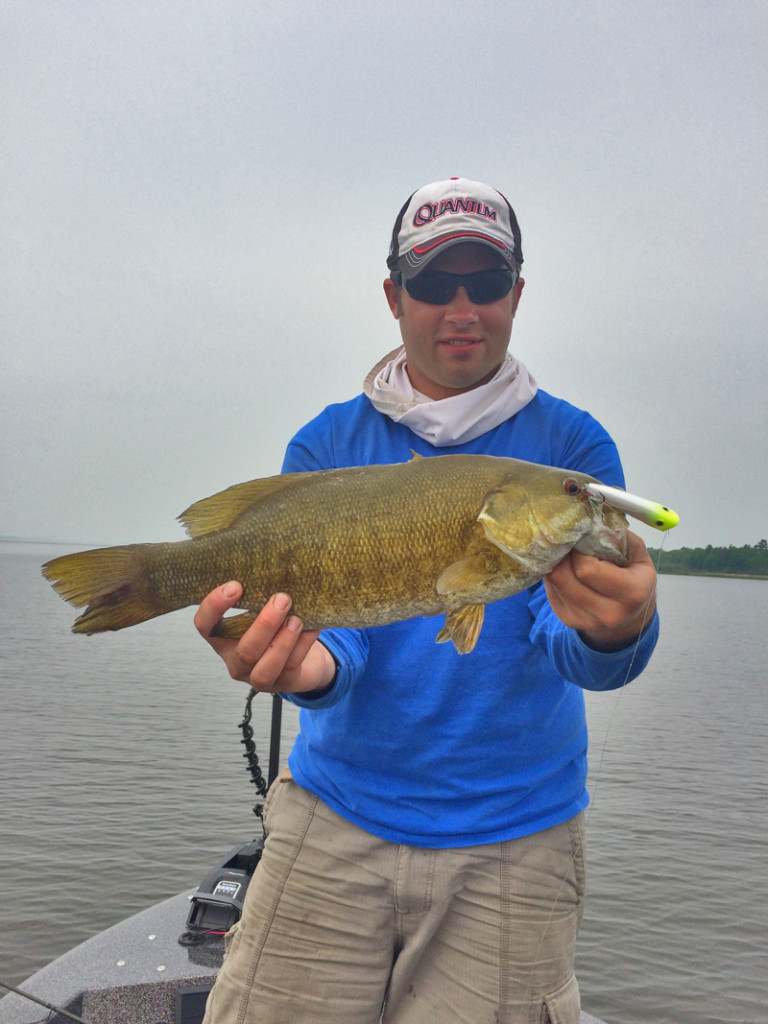 From May through June, most of the bay’s smallmouths will be on the east side sloughs and shallows of Sand Cut and Kakagon, using the shallow sand, wood, and emerging vegetation for spawning habitat. Fish will also slide out to Brush Point, Oak Point, and Long Island, using their shallow sand flats as well.
From May through June, most of the bay’s smallmouths will be on the east side sloughs and shallows of Sand Cut and Kakagon, using the shallow sand, wood, and emerging vegetation for spawning habitat. Fish will also slide out to Brush Point, Oak Point, and Long Island, using their shallow sand flats as well.
Spring is easy fishing, but from mid summer through fall Baron is challenged to break down this large body of water. We agree there is no shortage of spots out here. As Baron points out, their habitat and locations drastically change by mid summer.
Following spring, smallmouths will disperse and gradually move away from the shallows, using weed beds in 10-15 ft. depths before moving out to the bay’s deepest contour and colder waters. “Deeper weeds, dropoffs, sudden depth changes and ledges, the rock pile, and areas where there is a good current (seiche) are all key elements,” says Baron. “Fishing the tops of weeds in early morning, and their edges down to 18 to 24 ft. is the best,” he adds. The bay’s weeds are small isolated cabbage and grass beds scattered along the deeper edges of sand flats. Baron indicates these spots are about the size of a small house, and fishing them is his most consistent mid summer method.
“To locate these spots, I mark a ton of waypoints with my Lowrance unit with Navionics Plus chart,” says Baron. “I do it to establish the breakline, and to save a lot of time fishing unproductive water. A lot of my focus here is on bottom transitions such as clay/sand and sand/rock.”
These deeper habitats are located along Long Island, where its deep edges fish very well in late summer, and the Washburn shoreline out to the Houghton Point area. Much of the bay’s fishing in the colder northwest side is centered on deep rocks located 3 to 4 miles away from shore, and open water. “This region is most popular in late summer and fall,” says Baron.
By early to mid fall, most smallmouths move into the bay west of the Ashland breakwall, and begin using the deep shipping channels in front of Ashland for their overwintering habitat. Baron also suggests the rock pile off Bayfield and Houghton Point, as well as the deep humps off Ashland and its deep submerged wood. These areas close to town will hold autumn fish.
“Fall fishing on the bay is the most special time of the year,” says Baron. “What’s enjoyable is that you may catch a 6 lb. smallmouth on one cast, followed by a 10 lb. walleye on the next, or a big coho, a brown trout, or a northern pike.”
Seasonal Strategies
Due to the bay’s acreage, it’s essential for anglers like Baron to mark waypoints everywhere fish have been caught. “Most smallmouths here are often found in wolfpacks and small schools, often on the move,” he says. When fish are found, Baron parks his Tuffy in the anchor position using his Motor Guide XI-5’s GPS control to catch a few more, before moving onto the next spot.
“Letting the XI-5 do all the work for me, I use the heading lock, cruise, and anchor mode. It follows my waypoint trails along drop-offs, weed edges, and breaklines. When I hit the buttons it takes me back along the same routes so I can catch more fish,” quips Baron.
Quiet and responsive to the boat’s desired control, speed, and direction, this set up allows Baron and his clients to stay on top of moving smallmouths. “The anchor mode has been a definite game changer,” says Baron. “It is so precise that in any wind speed it will not move or drift the boat off the spot. Give me a 25 mph wind and it still holds the boat in position!” When this technology is used accordingly like this, it makes lake life and fishing much easier.
Per historical accounts and ancient shipwrecks, the bay’s weather can get downright nasty, thus making it too dangerous and unfishable. Wind is the driving factor in determining what allows the bay to be fishable or not. “The Great Lakes region here is one of the most difficult in the country to predict,” he exclaims.
Mobile phone apps such as WINDSURF and SAILFLOW, with other weather apps and NOAA can help determine when to fish. “Knowing what direction, speed, and when it will switch directions midday, which occurs often, determines the game plan,” he adds.
Baron likes a light to moderate wind, enough to reduce light penetration, as smallmouths respond better and are more active. Ideal wind speeds for Chequamegon Bay are 5 to 10 mph. Winds over 10 to 12 mph will be rough, and fishing is usually not advisable regardless of watercraft size.
“I’ve seen fishermen with big bass boats come here for a week and they can only get out fishing for a day or two because of the bay’s unpredictable wind,” says Baron. The boat you’re in makes a difference in the length and duration of the trip.
Baron’s Tackle Box
Baron’s largest smallmouth to date is a 22 ¼ incher, caught on a watermelon senko rigged wacky style from 3 ft. of water in early spring. It’s his only legal keeper-size fish over 22” in 4 years of guiding the bay.
“I am a fan of senkos and similar 5 inch stick baits,” says Baron. “They cast nicely because of weight and fall rate, and I fish them almost exclusively wacky style.”

Besides senkos, Baron also often fishes with fluke style minnows, Trigger-X paddle tails, tubes, and Berkley GULP! soft baits rigged on a jig head, or drop shot rig, depending on conditions.
Baron’s bass tactics call for diversity. His tackle box includes hardbaits such as Storm Arashi square bill crankbaits, Manns Baby Minuses, Rapala Scatter Raps, and Bandit 100 crankbaits. It also features jerkbaits such as Rapala X-Raps, Husky Jerks, and the new Shadow Rap. This list also includes spinnerbaits, Mepps #4 inline spinners, and topwaters such as Heddon Torpedoes and Zara Spooks, Storm Chug Bugs, and Rapala X-Raps.
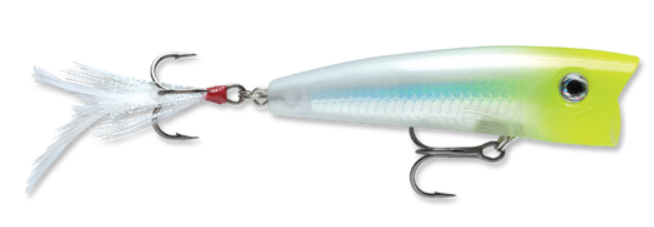
Last but not least, Baron won’t discount live bait as it’s a personal favorite of his. “There isn’t a single guide up here that doesn’t have a couple dozen walleye suckers in their livewell for tougher days,” he says.
Baron and I fished on the calmest of days in mid June, a rarity for Lake Superior, right in midst of the spawning period. Baron, equipped with his weightless wacky rigged senko, caught a dozen smallmouths up to 20 inches. Meanwhile, heavy surface activity of schooling smallmouths blowing up on minnows led to me fishing with one single Rapala X-Rap Pop for the entire day. I was hammering fish at rapid rate midday, catching numerous impressive specimens between 19 and 20 inches.
“I love fishing the early season during May and June because of the variety of lures and techniques that can be used,” Baron concludes.
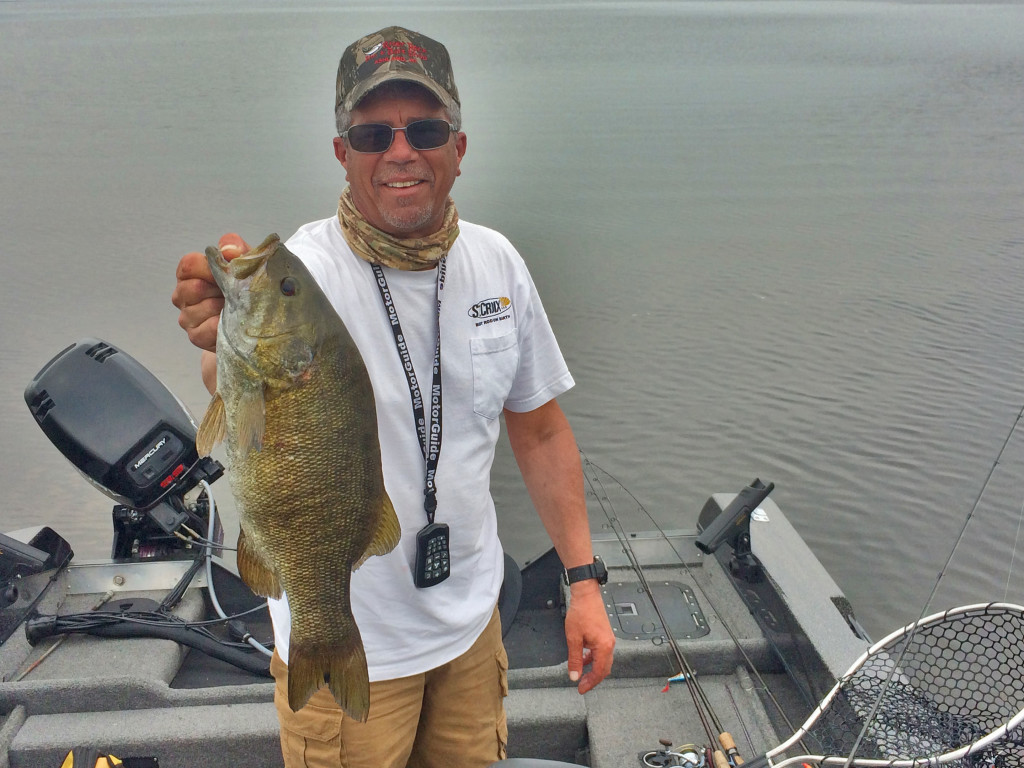
Free The Fighter
Chequamegon Bay has one of the best populations of smallmouth bass anglers will find anywhere in the world. Much of it has been attributed to the work done by the Wisconsin DNR, and the conservation work of Roger Lapenter, who led the movement for the existing 22 inch minimum rule that has helped revitalize the bay to half the fishery it once was.
The strict regulations on Chequamegon Bay are important to maintain because the bay is one of the best smallmouth bass fisheries in North America. Waters with high potential need continued protection in order to create more quality fishing experiences for the growing number of bass anglers who want them.
Today, the Wisconsin DNR in Washburn and Ashland closely monitors the fishery to make sure that the smallmouth bass populations and forage balance remains equal. I witnessed this stewardship by catching and releasing a 20 inch smallmouth with multiple tags inserted near its top dorsal fin, reaffirming this close watch on the fishery. As long as the bay continues to receive an influx of forage species from the deep water basin of Lake Superior, the bass fishery will continue to flourish and grow bigger specimens.
The city of Ashland is the bay’s largest town and offers plenty of accommodations. For more information, visit River Rock Inn Bait and Tackle (http://riverrockinn.net/), where guide Nate Baron and fellow staff will accommodate you. Rated 5 stars on Trip Advisor and open year round, the facility features a full service bait and tackle shop, and 11 motel units equipped with modern amenities with an outdoorsman theme.
To schedule a trip with Nate Baron, please visit him at River Rock Bait and Tackle, and on the web at www.upnorthguideservice.net. Anglers will experience an incredible smallmouth bass fishery with outstanding service and accommodations, and fish with a darn awesome individual who will be captaining you. Nate Baron: (608) 963-2758 / ifigr8m2@gmail.com


